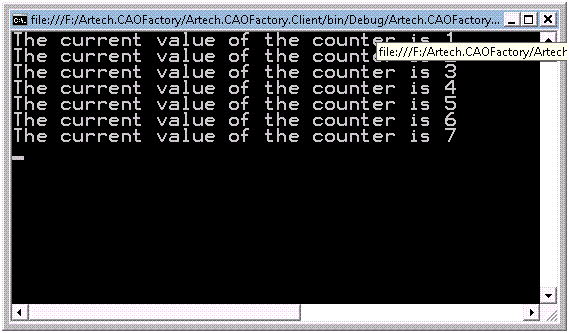[原创]我所理解的Remoting(3):创建CAO Service Factory使接口和实现相互分离
2007-04-02 19:28
591 查看
我们知道对于Remoting,有两种不同的Activation模式:Server Activation和Client Activation。他我在前面的系列文章中分析、比较了这两种不同激活方式的区别:Marshaling方式,远程对象创建的时机,状态的保持,生命周期的管理。 在编程模式方面Server Activation和Client Activation也具有一定的差异:为一个SAO(server activated object)和一个CAO(client activated object)注册一个远程对象类型的方式是不同的(Wellknown Service Type Re V.S. Activated Type Registration);为为一个SAO(server activated object)和一个CAO(client activated object)创建Proxy的方式也不一样:对于SAO,一般通过Activator的静态方法GetObject(传入一个远程对象的地址);而我们一般通过new 关键字或者Activator的静态方法CreateInstance。

String remoteAddress = "http://localhost/Artech.CAOFactory/CounterFactory.rem";

ICounter counter = ICounterFactory counterFactory = (ICounterFactory)Activator.GetObject(typeof(ICounterFactory), remoteAddress);

对于Client Activation,由于我们在创建Proxy对象的时候,必须利用远程对象对应的原数据,所以在Client端,需要引用远程的对象所对应的dll。比如我们现在做一个简单的计数器的例子(Client远程调用获得计数器当前的计数)我们把业务逻辑封装在Counter Service的实体中。下图反映了这样一种架构的依赖关系。

经验丰富的开发人员很快会意识到这是一种很不好的分布式构架。从SOA的角度来讲也是不值得推荐的构架方式。SOA崇尚的是Contract层面的共享,而拒绝Type层面的共享。Common Type增加了交互双方的依赖性,造成的紧耦合。所以我们一般从Service中把相对静态的Contract(可以简单地把 Contract看成是Service提供的所有操作的列表和调用的接口)提取出来,作为双方交互的契约:Client只要满足这个Contract,它就能够调用相应的Service,而Service 真正实现的改变对Client没有任何的影响,实际上Service的实现对于Client来说是完全透明的。我们可以说基于Contract的共享成就了SOA的松耦合。通过提取Contract之后,各个实体成为了下面一种依赖关系。

但是对于Client Activation,要直接实现这样的构架是不可能的。我们已经说过,Client创建一个CAO Proxy,需要和Host端注册的远程类型对应的原数据,换句话说,如果远程类型实现在CounterService的dll中,Host和Client双方都需要引用这个dll——虽然实现部分的代码对Client毫无意义。但是现在我们的目的的吧这个dll仅仅驻留在Host中,Client只需引用存储Contract的dll。
在一个分布式环境中,一个Application要跨AppDomain调用一个驻留在另一个AppDomain的的方法,他不需要获得这个真正的远程对象(而实事上它也不可能获得在另一个AppDomain中创建的对象),它只需要获得该对象的一个引用(说得具体点,它只需要获得该对象的ObjRef),并根据这个引用创建相应的Proxy来进行远程调用。或者说,我们只要通过某种方法把Server端创建的对象通过Marshaling传递到Client端,Client就可以进行远程调用了。
那么如何为一个远程调用从另一个AppDomain中获取一个远程对象的引用并创建Proxy呢?而这个获取的方式本身也是一个远程调用。我们的做法是:通过一个基于SAO的远程调用获取一个远程对象的引用并同时创建Proxy。而这个Proxy对应的远程对象就像当于一个CAO.
下面是我们的解决方案简要的类图。我们整个基于计数器的Service封装在CounterService中,它实现了ICounter接口,CounterFactoryService用于创建一个CounterService对象,它实现的接口是ICounterFactory。

现在我们就来实现它:
Step 1: 建立这个Solution的整体结构
整个Solution包含3个Project:Artech.CAOFactory.Contract;Artech.CAOFactory.Service;Artech.CAOFactory.Client。Artech.CAOFactory.Contract被Artech.CAOFactory.Service和Artech.CAOFactory.Client引用。我们使用IIS的Host方式,从而省略了Host Application。

Step 2 创建Contract
ICounter

using System;

using System.Collections.Generic;

using System.Text;


namespace Artech.CAOFactory.Contract



{

public interface ICounter



{

int GetCount();

}

}

ICounterFactory

using System;

using System.Collections.Generic;

using System.Text;


namespace Artech.CAOFactory.Contract



{

public interface ICounterFactory



{

ICounter CreateService();

}

}

Step 3 实现Contract:Artech.CAOFactory.Service

using System;

using System.Collections.Generic;

using System.Text;

using Artech.CAOFactory.Contract;


namespace Artech.CAOFactory.Service



{

public class CounterService : MarshalByRefObject,ICounter



{

private int _count;



ICounter Members#region ICounter Members


public int GetCount()



{

this._count++;

return this._count;

}


#endregion

}

}

CounterFactoryService

using System;

using System.Collections.Generic;

using System.Text;

using Artech.CAOFactory.Contract;


namespace Artech.CAOFactory.Service



{

public class CounterFactoryService :MarshalByRefObject, ICounterFactory



{



ICounterFactory Members#region ICounterFactory Members


public ICounter CreateService()



{

return new CounterService();

}


#endregion

}

}

Step 3 通过IIS Host CounterFactoryService
修改编译配置把Dll生成在Project根目录的bin目录下,基于这个根目录创建虚拟目录(假设Alias就是Artech.CAOFactory),并添加Web.config。

<?xml version="1.0"?>

<configuration>

<configSections>

<section name="WorkflowRuntime" type="System.Workflow.Runtime.Configuration.WorkflowRuntimeSection, System.Workflow.Runtime, Version=3.0.00000.0, Culture=neutral, PublicKeyToken=31bf3856ad364e35" />

</configSections>

<WorkflowRuntime Name="WorkflowServiceContainer">

<Services>

<add type="System.Workflow.Runtime.Hosting.ManualWorkflowSchedulerService, System.Workflow.Runtime, Version=3.0.0.0, Culture=neutral, PublicKeyToken=31bf3856ad364e35" />

<add type="System.Workflow.Runtime.Hosting.DefaultWorkflowCommitWorkBatchService, System.Workflow.Runtime, Version=3.0.0.0, Culture=neutral, PublicKeyToken=31bf3856ad364e35" />

</Services>

</WorkflowRuntime>

<appSettings/>

<connectionStrings/>

<system.web>

<compilation debug="false"/>

<authentication mode="Windows"/>

</system.web>

<system.runtime.remoting>

<application>

<service>

<wellknown type="Artech.CAOFactory.Service.CounterFactoryService, Artech.CAOFactory.Service"

mode ="SingleCall" objectUri="CounterFactory.rem"></wellknown>

</service>

</application>

</system.runtime.remoting>

</configuration>

Step 4 创建客户端Artech.CAOFactory.Client
Program

using System;

using System.Collections.Generic;

using System.Text;

using Artech.CAOFactory.Contract;

using System.Threading;

using System.Runtime.Remoting;


namespace Artech.CAOFactory.Client



{

class Program



{

const string REMOTE_ADDRESS = "http://localhost/Artech.CAOFactory/CounterFactory.rem";

static void Main(string[] args)



{

ICounterFactory counterFactory = (ICounterFactory)Activator.GetObject(typeof(ICounterFactory), REMOTE_ADDRESS);

ICounter counter = counterFactory.CreateService();


while (true)



{

Console.WriteLine("The current value of the counter is {0}", counter.GetCount());

Thread.Sleep(5000);

}

}

}

}

从上面的代码我们可以看到,我们希望使用的远程对象的Proxy(counter),是通过另一个SongleCall Proxy(counterFactory)获得的。
下面来运行,从输出结果来看,和我们平常使用的SAO方式的结果没有什么两样——同一个Proxy之间的调用状态被保留。

相关章节:
[原创]我所理解的Remoting(1):Marshaling & Activation - Part I
[原创]我所理解的Remoting(1):Marshaling & Activation - Part II
[原创]我所理解的Remoting(2):远程对象生命周期的管理—Part I
[原创]我所理解的Remoting (2) :远程对象的生命周期管理-Part II
[原创]我所理解的Remoting(3):创建CAO Service Factory使接口和实现相互分离
[原创].NET Remoting: 如何通过Remoting实现双向通信(Bidirectional Communication)

String remoteAddress = "http://localhost/Artech.CAOFactory/CounterFactory.rem";

ICounter counter = ICounterFactory counterFactory = (ICounterFactory)Activator.GetObject(typeof(ICounterFactory), remoteAddress);

对于Client Activation,由于我们在创建Proxy对象的时候,必须利用远程对象对应的原数据,所以在Client端,需要引用远程的对象所对应的dll。比如我们现在做一个简单的计数器的例子(Client远程调用获得计数器当前的计数)我们把业务逻辑封装在Counter Service的实体中。下图反映了这样一种架构的依赖关系。

经验丰富的开发人员很快会意识到这是一种很不好的分布式构架。从SOA的角度来讲也是不值得推荐的构架方式。SOA崇尚的是Contract层面的共享,而拒绝Type层面的共享。Common Type增加了交互双方的依赖性,造成的紧耦合。所以我们一般从Service中把相对静态的Contract(可以简单地把 Contract看成是Service提供的所有操作的列表和调用的接口)提取出来,作为双方交互的契约:Client只要满足这个Contract,它就能够调用相应的Service,而Service 真正实现的改变对Client没有任何的影响,实际上Service的实现对于Client来说是完全透明的。我们可以说基于Contract的共享成就了SOA的松耦合。通过提取Contract之后,各个实体成为了下面一种依赖关系。

但是对于Client Activation,要直接实现这样的构架是不可能的。我们已经说过,Client创建一个CAO Proxy,需要和Host端注册的远程类型对应的原数据,换句话说,如果远程类型实现在CounterService的dll中,Host和Client双方都需要引用这个dll——虽然实现部分的代码对Client毫无意义。但是现在我们的目的的吧这个dll仅仅驻留在Host中,Client只需引用存储Contract的dll。
在一个分布式环境中,一个Application要跨AppDomain调用一个驻留在另一个AppDomain的的方法,他不需要获得这个真正的远程对象(而实事上它也不可能获得在另一个AppDomain中创建的对象),它只需要获得该对象的一个引用(说得具体点,它只需要获得该对象的ObjRef),并根据这个引用创建相应的Proxy来进行远程调用。或者说,我们只要通过某种方法把Server端创建的对象通过Marshaling传递到Client端,Client就可以进行远程调用了。
那么如何为一个远程调用从另一个AppDomain中获取一个远程对象的引用并创建Proxy呢?而这个获取的方式本身也是一个远程调用。我们的做法是:通过一个基于SAO的远程调用获取一个远程对象的引用并同时创建Proxy。而这个Proxy对应的远程对象就像当于一个CAO.
下面是我们的解决方案简要的类图。我们整个基于计数器的Service封装在CounterService中,它实现了ICounter接口,CounterFactoryService用于创建一个CounterService对象,它实现的接口是ICounterFactory。

现在我们就来实现它:
Step 1: 建立这个Solution的整体结构
整个Solution包含3个Project:Artech.CAOFactory.Contract;Artech.CAOFactory.Service;Artech.CAOFactory.Client。Artech.CAOFactory.Contract被Artech.CAOFactory.Service和Artech.CAOFactory.Client引用。我们使用IIS的Host方式,从而省略了Host Application。

Step 2 创建Contract
ICounter

using System;

using System.Collections.Generic;

using System.Text;


namespace Artech.CAOFactory.Contract



{

public interface ICounter



{

int GetCount();

}

}

ICounterFactory

using System;

using System.Collections.Generic;

using System.Text;


namespace Artech.CAOFactory.Contract



{

public interface ICounterFactory



{

ICounter CreateService();

}

}

Step 3 实现Contract:Artech.CAOFactory.Service

using System;

using System.Collections.Generic;

using System.Text;

using Artech.CAOFactory.Contract;


namespace Artech.CAOFactory.Service



{

public class CounterService : MarshalByRefObject,ICounter



{

private int _count;



ICounter Members#region ICounter Members


public int GetCount()



{

this._count++;

return this._count;

}


#endregion

}

}

CounterFactoryService

using System;

using System.Collections.Generic;

using System.Text;

using Artech.CAOFactory.Contract;


namespace Artech.CAOFactory.Service



{

public class CounterFactoryService :MarshalByRefObject, ICounterFactory



{



ICounterFactory Members#region ICounterFactory Members


public ICounter CreateService()



{

return new CounterService();

}


#endregion

}

}

Step 3 通过IIS Host CounterFactoryService
修改编译配置把Dll生成在Project根目录的bin目录下,基于这个根目录创建虚拟目录(假设Alias就是Artech.CAOFactory),并添加Web.config。

<?xml version="1.0"?>

<configuration>

<configSections>

<section name="WorkflowRuntime" type="System.Workflow.Runtime.Configuration.WorkflowRuntimeSection, System.Workflow.Runtime, Version=3.0.00000.0, Culture=neutral, PublicKeyToken=31bf3856ad364e35" />

</configSections>

<WorkflowRuntime Name="WorkflowServiceContainer">

<Services>

<add type="System.Workflow.Runtime.Hosting.ManualWorkflowSchedulerService, System.Workflow.Runtime, Version=3.0.0.0, Culture=neutral, PublicKeyToken=31bf3856ad364e35" />

<add type="System.Workflow.Runtime.Hosting.DefaultWorkflowCommitWorkBatchService, System.Workflow.Runtime, Version=3.0.0.0, Culture=neutral, PublicKeyToken=31bf3856ad364e35" />

</Services>

</WorkflowRuntime>

<appSettings/>

<connectionStrings/>

<system.web>

<compilation debug="false"/>

<authentication mode="Windows"/>

</system.web>

<system.runtime.remoting>

<application>

<service>

<wellknown type="Artech.CAOFactory.Service.CounterFactoryService, Artech.CAOFactory.Service"

mode ="SingleCall" objectUri="CounterFactory.rem"></wellknown>

</service>

</application>

</system.runtime.remoting>

</configuration>

Step 4 创建客户端Artech.CAOFactory.Client
Program

using System;

using System.Collections.Generic;

using System.Text;

using Artech.CAOFactory.Contract;

using System.Threading;

using System.Runtime.Remoting;


namespace Artech.CAOFactory.Client



{

class Program



{

const string REMOTE_ADDRESS = "http://localhost/Artech.CAOFactory/CounterFactory.rem";

static void Main(string[] args)



{

ICounterFactory counterFactory = (ICounterFactory)Activator.GetObject(typeof(ICounterFactory), REMOTE_ADDRESS);

ICounter counter = counterFactory.CreateService();


while (true)



{

Console.WriteLine("The current value of the counter is {0}", counter.GetCount());

Thread.Sleep(5000);

}

}

}

}

从上面的代码我们可以看到,我们希望使用的远程对象的Proxy(counter),是通过另一个SongleCall Proxy(counterFactory)获得的。
下面来运行,从输出结果来看,和我们平常使用的SAO方式的结果没有什么两样——同一个Proxy之间的调用状态被保留。

相关章节:
[原创]我所理解的Remoting(1):Marshaling & Activation - Part I
[原创]我所理解的Remoting(1):Marshaling & Activation - Part II
[原创]我所理解的Remoting(2):远程对象生命周期的管理—Part I
[原创]我所理解的Remoting (2) :远程对象的生命周期管理-Part II
[原创]我所理解的Remoting(3):创建CAO Service Factory使接口和实现相互分离
[原创].NET Remoting: 如何通过Remoting实现双向通信(Bidirectional Communication)
相关文章推荐
- 我所理解的Remoting(3):创建CAO Service Factory使接口和实现相互分离
- 在Remoting客户端激活方式采用替换类以分离接口与实现
- 简单工厂(Factory)-提供一个创建对象实例的功能,而无须关心其具体实现。被创建实例的类型可以是接口、抽象类,也可以是具体的类。
- “Oracle.DataAccess.Client.OracleClientFactory”未实现 IServiceProvider 接口
- 学习笔记:使用Web Service Software Factory开发简易留言本服务以及Mobile调用实现-1.创建Service
- spring 通过中间层工具类SpringBeanFactoryUtils 实现service 注入
- 超时,可以用Java线程池ExecutorService类配合Future接口来实现
- (C语言版)链表(一)——实现单向链表创建、插入、删除等简单操作(包含个人理解说明及注释,新手跟着写代码)
- 通过继承Thread类和通过实现Runnable接口 创建线程的区别
- C语言接口与实现-创建可重用软件的技术 (笔记10)
- C语言接口与实现-创建可重用软件的技术(笔记12)
- Spring-Bean的初始化(init方法和实现org.springframework.beans.factory.InitializingBean接口)
- C++封装SDK的一种方法(接口与实现分离)
- Java的接口Interface和接口实现Implentmens的理解
- Android(java)学习笔记229:服务(service)之绑定服务调用服务里面的方法 (采用接口隐藏代码内部实现)
- 定制并发类(四)实现ThreadFactory接口生成自定义的线程
- 多线程之创建线程的方式之一:实现Callable接口
- C++中接口与实现分离的技术
- C++中接口与实现分离的技术
- Android实训案例(七)——四大组件之一Service初步了解,实现通话录音功能,抽调接口
